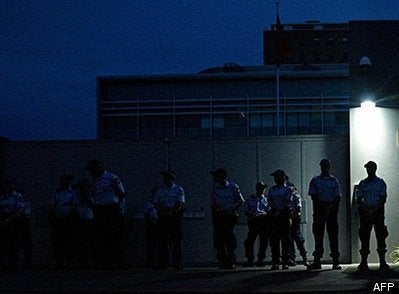
Several weeks ago DHS Secretary Janet Napolitano announced DHS has decided to emulate
the widespread World War II strategy of actively involving the public in
terrorism and disaster planning and response. As
the Secretary said, "For too long we've treated
the public as a liability to be protected rather than an asset in our nation's
collective security."
Crafting an effective strategy to productively involve the general
public in homeland security should center on two technologies: the increasingly powerful and versatile mobile communication devices that most of us now carry and the Web 2.0 social media that have been created to capitalize on them.
The reality, as every major disaster in recent years has proven, is that we will use these devices in an emergency, whether or not government wants us to. They have become so ingrained in our daily communication routines that we'd automatically turn to them in disasters as well.
Even better, in an era of fiscal limits, instead of government having to hire contractors to build centralized communication systems that are vulnerable to attack because they are centralized; are unlikely, given the history of such projects, to ever work as promised; and are likely to cost billions; you and I not only gladly buy the hardware for such a system, but
even pay for constant upgrades!
Even better, since trust is critical in an emergency, we've built far-reaching social networks online that will give credibility to messages that we either originate or pass on from officials.
Best of all, there are a lot more of us who don't wear uniforms than who do, and we can provide real-time information that can be a matter of life-or-death in a crisis (not unlike the World War II plane spotters): the ultimate "force multiplier"; again at no cost to government. Whadda bargain!
Properly encouraged and coached by government, the result can be what href="http://www.icosystem.com/about_management.htm">emergent behavior guru
Eric Bonabeau and I outlined in href="http://www.hsaj.org/?article=3.1.3">a paper for the Homeland Security Affairs journal: "networked homeland security."
Such a strategy must be as fast-changing as the technology and social media tools that make it possible, in part because we know the terrorists are also using the same cell-phones and other technologies, and they place a premium on rapidly changing their tactics. In their 1996 book, The Advent of Netwar, John Arquilla and David Ronfeldt described the rise of networked enemies "[who are] organized along networked lines or employ networks for operational control and other communications," and logically argued that it takes a networked response to fight a networked enemy.
It also must take advantage of the growing range of devices and applications that are able to share packet- and IP-based communications, because they can steer around system interruptions in ways that analog communications cannot, increasing the chances they will get through in a severely compromised network.
It's important to note that an effective networked homeland security strategy can't be built around a specific device or application, because it is impossible to known in advance which of them might still be usable. In fact, as I write this, it is impossible to use Twitter href="http://latimesblogs.latimes.com/technology/2009/08/twitter-paralyzed-by-denial-of-service-attack.html">because of the first massive Denial of Service (DoS) attack against the system, and terrorists might launch such an attack as part of their tactics.
Instead, it must think in terms of what I refer to "the mix," using href="http://twitter.com/LAFDtalk/status/3168275640">a redundant series of
applications and devices including alternatives such as href="http://search.twitter.com/search?q=%23wildfire">Twitter, Qik real-time videos, href="http://www.sirius.com/traffic">Sirius real-time traffic alerts, or even, in a worst-case when all cutting-edge media are
knocked out, href="http://www.youtube.com/watch?v=8twBaixrvCo">ad hoc walkie-talkie networks. That will increase the chances that at least some channels are still open.
The public have already kept our part of the bargain, buying these advanced mobile
devices and mastering social apps that can be invaluable in disasters.
Now the burden is on government to meet us halfway.
That involves two things: coaching us on what kind of information would be helpful in an emergency, and, when one happens, both factoring in real-time location-based info from the public into their actionable intelligence for responding, and using social media to guide us.
Even though I'm constantly on the lookout for such things, I have yet to see advice from any municipality, state or the federal government on what kind of information would be most helpful to them from citizen-responders. That's particularly critical for videos, since they can be so informative regarding damage, locations, traffic, and weather conditions. But why leave us guessing as to what would be helpful?
Also, it's important that government agencies begin building a relationship with social media communities in advance of an emergency, both to build mind-share and credibility, so that we'll look to them as part of our trusted networks in time of need. The LA Fire Department's use of Twitter, which includes a tweet each time a unit is dispatched, is particularly noteworthy in this regard.
Secondly, government has to begin specifically factoring in monitoring the social media
in crises to look for valuable real-time information that it can't get elsewhere. There is evidence, such as the
Air Force monitoring Twitter streams during the inane Air Force One flyover
stunt, that agencies are beginning to do this, but it is far from commonplace.
I've explained many of the specific options in such a strategy in a series of
YouTube videos called "21-century
disaster tips you won't get from officials," named when I did them several years ago as a gentle tweek at officialdom for ignoring the power of personal communication devices and social media apps in emergencies.
Following Sec. Napolitano's speech I'm considering just calling them "21-century disaster tips." Pardon my skepticism, but I'll wait to actually make that change until government agencies take tangible steps to both guide us on how to
use these devices and apps in emergencies andbegin monitoring and using them in the midst of emergencies.
Take care (and make sure your iPhone is charged!)